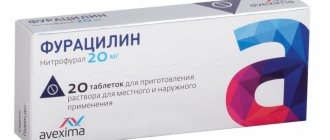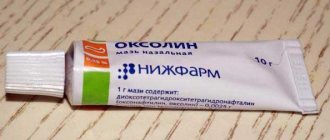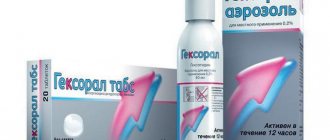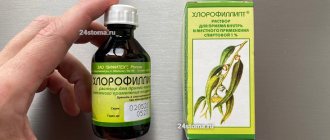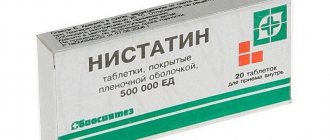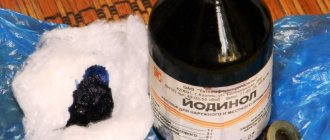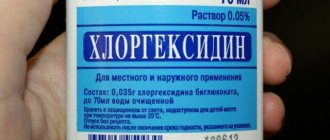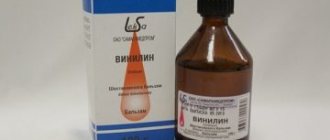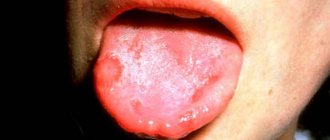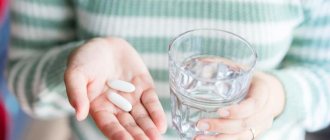Iodinol is an antiseptic solution that contains iodine and polyvinyl alcohol. This drug has long been included in the treatment regimen for stomatitis in children and adults. The substances that make up Iodinol are capable of destroying all pathogenic bacteria in a matter of minutes.
Iodinol
How to use Iodinol in the treatment of stomatitis?
September 27, 2016, 10:17 Article expert: Daria Dmitrievna Blinova 5.755
- 1 Definition
- 2 Advantages and disadvantages
- 3 Use for stomatitis
- 4 In children
- 5 In adults
- 6 Precautions
- 7 Contraindications
- 8 Side effects
- 9 Analogues
When treating stomatitis, it is most effective to use iodine-based medications. They have a disinfecting effect and can be used in childhood. “Iodinol” for stomatitis is one of the best medicines and, when used correctly, is safe for the patient. If you use the medicine according to the instructions, you can cure inflammation of the oral cavity and nearby tissues in a matter of days.
The drug “Iodinol” is good at eliminating ulcers in the mouth, also providing a general antiseptic effect.
Clinic, diagnosis and treatment of acute herpetic stomatitis in children
- What is the clinical picture of acute herpetic stomatitis?
- What are the new treatment regimens?
The problem of diseases of the oral mucosa is one of the most important in dentistry.
Acute herpetic stomatitis occupies a special place here, primarily because it accounts for more than 80% of all diseases of the oral mucosa in children. The combined use of virological, serological and immunofluorescence research methods confirms that acute herpetic stomatitis is one of the clinical forms of primary herpetic infection.
The spread of the disease in 71% of cases among children aged 1 to 3 years is explained by the fact that at this age, antibodies received from the mother interplacentally disappear in children, as well as the lack of mature specific immune systems. Among older children, the incidence is significantly lower due to acquired immunity after a herpes infection in its various clinical manifestations.
Great importance in the pathogenesis of the disease is attached to the lymph nodes and elements of the reticuloendothelial system, which is quite consistent with the pathogenesis of the sequential development of clinical signs of stomatitis. The appearance of lesions on the oral mucosa is preceded by lymphadenitis of varying severity. Most often they are observed in severe and moderate stomatitis. As a rule, lymphadenitis is bilateral, submandibular. However, with moderate and severe forms of the disease, simultaneous involvement of the cervical lymph nodes in the process is also possible. Lymphadenitis accompanies the entire period of the disease and persists for 7-10 days after complete epithelization of the elements.
The body's resistance to the disease is determined by its immunological defense. Both specific and nonspecific immune factors play a role in immunological reactivity. Violation of nonspecific immunological reactivity determines the severity of the disease and the periods of its development. Moderate and severe forms of stomatitis led to a sharp suppression of natural immunity, which was restored 7-14 days after the child’s clinical recovery.
The severity of acute herpetic stomatitis is assessed by the severity and nature of toxicosis and damage to the oral mucosa. The development of the disease goes through five periods: incubation, prodromal, period of disease development, extinction and clinical recovery.
| Elements of herpetic stomatitis |
The mild form of acute herpetic stomatitis is characterized by an external absence of symptoms of intoxication; the prodromal period is clinically absent.
The disease begins suddenly with an increase in temperature to 37-37.5°C. The general condition of the child is quite satisfactory. In the oral cavity there are signs of hyperemia and slight swelling, mainly in the area of the gingival margin (catarrhal gingivitis). In most cases, against the background of increased hyperemia, single or grouped lesions appear in the oral cavity, the number of which usually does not exceed six. The rashes are one-time only. The duration of the disease development is 1-2 days.
The period of extinction of the disease is longer. Within 1-2 days, the elements acquire a marble-like color, their edges and center are blurred. They are already less painful. After epithelialization of the elements, the phenomena of catarrhal gingivitis persist for 2-3 days, especially in the area of the anterior teeth of the upper and lower jaw.
In children suffering from this form of the disease, as a rule, there are no changes in the blood, sometimes only towards the end of the disease a slight lymphocytosis appears (in children 1-3 years old, the number of lymphocytes is normally up to 50%). Herpetic complement-fixing antibodies are not often detected during convalescence. In this form, the protective mechanisms of saliva are well expressed: pH 7.4±0.04, which corresponds to the optimal state. At the height of the disease, the antiviral factor interferon appears in saliva from 8 to 12 units/ml. The decrease in lysozyme in saliva is not pronounced.
The moderate form of acute herpetic stomatitis is characterized by fairly clearly defined symptoms of toxicosis and damage to the oral mucosa during all periods of the disease. Already in the prodromal period, the child’s well-being worsens, weakness, loss of appetite appear, the child is capricious, there may be catarrhal tonsillitis or symptoms of an acute respiratory disease. The submandibular lymph nodes enlarge and become painful. The temperature rises to 37-37.5°C.
As the disease progresses (catarrhal phase), the temperature reaches 38-39°C, headache, nausea, and pale skin appear. At the peak of the rise in temperature, increased hyperemia and severe swelling of the mucous membrane, elements of the lesion appear both in the oral cavity and on the skin of the face in the perioral area. In the oral cavity there are usually from 10 to 20-25 lesions. During this period, salivation increases, saliva becomes viscous and viscous. Severe gingivitis and bleeding gums are noted.
Rashes often recur, as a result of which, when examining the oral cavity, one can see elements of the lesion that are at different stages of clinical and cytological development. After the first eruption of lesions, body temperature usually drops to 37-37.5°C. However, subsequent rashes are usually accompanied by a rise in temperature to the previous levels. The child does not eat, sleeps poorly, and symptoms of secondary toxicosis increase.
An ESR of up to 20 mm/hour is observed in the blood, often leukopenia, sometimes slight leukocytosis. Band and monocytes within the higher limits of normal, lymphocytosis and plasmacytosis. An increase in the titer of herpetic complement-fixing antibodies is detected more often than after suffering a mild form of stomatitis.
The duration of the period of extinction of the disease depends on the resistance of the child’s body, the presence of carious and damaged teeth in the oral cavity, and irrational therapy. The latter factors contribute to the fusion of lesion elements, their subsequent ulceration, and the appearance of ulcerative gingivitis. Epithelization of the lesion elements takes up to 4-5 days. Gingivitis, severe bleeding and lymphadenitis last the longest.
With a moderate course of the disease, the pH of saliva becomes more acidic, reaching 6.96 ± 0.07 during rashes. The amount of interferon is less than in children with a mild course of the disease, but does not exceed 8 units/ml and is not detected in everyone. The content of lysozyme in saliva decreases more than in mild forms of stomatitis. The temperature of the unchanged oral mucosa is in accordance with the child’s body temperature, while the temperature of the affected elements in the degeneration stage is 1.0-1.2°C lower than the temperature of the unchanged mucosa. With the beginning of regeneration and during the period of epithelization, the temperature of the affected elements rises to 1.80 and remains at a higher level until complete epithelization of the affected mucosa.
The severe form of acute herpetic stomatitis is much less common than the moderate and mild form.
During the prodromal period, all the signs of an incipient acute infectious disease occur: apathy, adynamia, headache, musculocutaneous hyperesthesia and arthralgia, etc. Symptoms of damage to the cardiovascular system are often observed: bradycardia and tachycardia, muffled heart sounds, arterial hypotension. Some children experience nosebleeds, nausea, vomiting, and pronounced lymphadenitis of not only the submandibular, but also the cervical lymph nodes.
During the development of the disease, the temperature rises to 39-40°C. The child has a mournful expression on his lips and painfully sunken eyes. There may be a mild runny nose, coughing, and the conjunctivae of the eyes are somewhat swollen and hyperemic. Lips are dry, bright, parched. In the oral cavity, the mucous membrane is swollen, clearly hyperemic, with pronounced gingivitis.
After 1-2 days, lesions up to 20-25 begin to appear in the oral cavity. Often, rashes in the form of typical herpetic blisters form on the skin of the perioral area, the skin of the eyelids and conjunctiva of the eyes, the lobes of the ears, on the fingers, like a panaritium. Rashes in the oral cavity recur, and therefore at the height of the disease in a seriously ill child there are about 100 of them. The elements merge, forming extensive areas of mucosal necrosis. Not only the lips, cheeks, tongue, soft and hard palate are affected, but also the gingival margin. Catarrhal gingivitis turns into ulcerative-necrotic. A sharp putrid odor from the mouth, profuse salivation mixed with blood. Inflammation in the mucous membranes of the nose, respiratory tract, and eyes worsens. Streaks of blood are also found in secretions from the nose and larynx, and sometimes nosebleeds are observed. In this condition, children need active treatment from a pediatrician and dentist, and therefore it is advisable to hospitalize the child in a boxed ward of a children's or infectious diseases hospital.
In the blood of children with severe stomatitis, leukopenia, a band shift to the left, eosinophilia, single plasma cells, and young forms of neutrophils are detected. In the latter, toxic granularity is very rarely observed. Herpetic complement-fixing antibodies are, as a rule, always detected during the period of convalescence.
Saliva has an acidic environment (pH 6.55±0.2), which can then be replaced by more pronounced alkalinity (8.1-8.4). Interferon is usually absent, the content of lysozyme is sharply reduced.
The diagnosis of acute herpetic stomatitis is made based on the clinical picture of the disease. The use of virological and serological diagnostic methods, especially in practical healthcare, is difficult. This is primarily due to the difficulty of conducting special research methods. In addition, with these methods, results can be obtained at best towards the end of the disease or some time after recovery. Such a retrospective diagnosis cannot satisfy the clinician.
It should be emphasized that in recent years the immunofluorescence method has been increasingly used. The high percentage of coincidences (79.0±0.6%) of the diagnosis of acute herpetic stomatitis, according to immunofluorescence data, with the results of virological and serological studies make this method the leading one in diagnosing the disease.
The doctor’s tactics when treating patients with acute herpetic stomatitis should be determined by the severity of the disease and the period of its development.
Due to the peculiarities of the course of acute herpetic stomatitis, rational nutrition and proper organization of feeding the patient occupy an important place in the complex of therapeutic measures. Food must be complete, that is, contain all the necessary nutrients, as well as vitamins. Therefore, it is necessary to include fresh vegetables, fruits, berries, and juices in your diet. Before feeding, the oral mucosa should be anesthetized with a 2-5% solution of anesthetic emulsion.
The child is fed predominantly liquid or semi-liquid food that does not irritate the inflamed mucous membrane. It is necessary to give the child enough fluids. This is especially important during intoxication. During meals, natural gastric juice or its substitutes should be given, since when there is pain in the mouth, the enzymatic activity of the stomach glands reflexively decreases.
Local therapy for acute herpetic stomatitis has the following objectives:
- relieve or reduce painful symptoms in the oral cavity;
- prevent repeated eruptions of lesions (reinfection) and promote their epithelization.
From the first days of the disease, given its etiology, in local treatment, serious attention should be paid to antiviral therapy. For this purpose, it is recommended to use 0.25% oxolinic, 0.5% tebrofen ointments, Zovirax, solutions of interferon and neoferon.
It is recommended to use the listed medications repeatedly (3-4 times a day) not only when visiting a dentist, but also at home. It should be borne in mind that antiviral agents must be applied to both the affected areas of the mucosa and areas that do not contain elements of the lesion, since they have more of a preventive effect than a therapeutic one.
During the period of extinction of the disease, antiviral drugs can be discontinued.
Particular importance should be attached to keratoplasty agents at this time. These are primarily oil solutions A and B, sea buckthorn oil, caratoline, rosehip oil, ointments with methyluracil, and an oxygen cocktail.
A study of the state of local immunity in children with acute herpetic stomatitis revealed that it correlates with the nature of the pathological process, therefore we consider it pathogenetically justified to include measures aimed at their elimination in a comprehensive treatment regimen.
At the Department of Pediatric Therapeutic Dentistry of the Moscow State Medical University, the drug imudon from Solvay pharma was prescribed to 80 children aged 2 to 4.5 years in the complex treatment of acute herpetic stomatitis. 40 children were diagnosed with mild, 38 children with moderate and 2 with severe forms of stomatitis.
Imudon is a mixture of lysates: 0.050 g (dry product) Lactobassillus acidophilus, fermentatum, helveticus, lactis Streptococcus pyogenes (2 var.), faecalis, faecium, sanguinis Staphilococcus aureus Klebsiella pneumoniae, Corynebacterium pseudodiphteriticum, Fusiformis fusiformis, Candida albicans.
Preservative: Sodium mercurothiolate: 0.0125 mg.
Excipients: lactose, mannitol, saccharin, sodium bicarbonate, anhydrous citric acid, precirol fine, magnesium stearate, polyvinylpyrrolidone.
pharmachologic effect
Imudon is intended for local specific immunotherapy of diseases of the oral cavity and pharynx. The effect of the drug on the immune system is expressed in an increase in the phagocytic activity of macrophages, an increase in the content of lysozyme in saliva, as well as an increase in the number of immunocompetent cells and the content of local antibodies (class A immunoglobulins). Thus, imudon has a therapeutic specific antimicrobial and anti-inflammatory effect, and also, by increasing the immune local protective barrier, ensures the prevention of relapses.
The first group consisted of children treated with 0.5% tebrofen ointment, the second group included children treated with interferon solution. In the third group, on the day of treatment, in addition to 0.5% tebrofen, imudon was prescribed, and in the fourth group, imudon + interferon. Children took Imudon tablets 5-6 times a day, no earlier than 30-40 minutes after treating the oral cavity with antiviral ointment, and dissolved it in the oral cavity.
Criteria for clinical and laboratory assessment of the therapeutic effectiveness of the drug imudon:
- The therapeutic effect is the average recovery time.
- Analgesic effect.
- General and local reactions to the drug.
- Influence on the state of local immunity.
Recovery was considered to be the epithelization of the lesion elements without a complete cure of the child from acute herpetic stomatitis, the duration of which is determined not only by the end of the epithelization of the lesion elements, but also by the duration of gingivitis and lymphadenitis, as well as deviations in the general well-being of the child.
As can be seen from table. 1, timely correction of local immunity increases the effectiveness of ongoing treatment measures and allows for faster recovery of children with AHS.
The effectiveness of the drug was manifested in groups 3 and 4 on the second day in case of contacting a doctor on the first day of the disease: erosions did not develop into aphthae, and the surrounding mucous membrane was not infiltrated.
Table data 1 indicate the advantage of complex therapy for OGS over generally accepted methods of treatment, its high efficiency, confirmed by a reliable reduction in the time of epithelization of elements and recovery of children.
The more effectively the drug stops the disease, the faster it normalizes the pathological infectious process, the more actively the factors of local immunological defense are restored. (Table 2).
We have given a high assessment of the effectiveness of the new regimen of complex therapy for AHS using stimulating immunotherapy, in particular imudon; It was concluded that there is a fundamental need for an integrated approach to the treatment of acute herpetic stomatitis with the mandatory inclusion of imudon, both a stimulating and a replacement agent for the correction of local immunity.
Thus, the high effectiveness of imudon in the treatment of AHS due to the immune correction of saliva has been established. Imudon has a therapeutic, anti-inflammatory effect, reduces the time for epithelization of lesions. There were no complications or side effects when using the drug imudon. Children used the drug with pleasure, as it has a pleasant, minty taste that does not irritate the mucous membrane. Apparently due to the mint aroma there is a weak analgesic effect.
All this allows us to recommend imudon in the complex therapy of acute herpetic stomatitis in children.
In conclusion, it should be noted that acute herpetic stomatitis, occurring in any form, is an acute infectious disease and requires in all cases the attention of a pediatrician and dentist in order to provide comprehensive treatment, eliminate contact of a sick child with healthy children, and take measures to prevent this diseases in children's groups.
Composition, release form and mechanism of action
The pharmaceutical drug “Iodinol” is produced in the form of a solution, which is used for the treatment of stomatitis in both children and adult patients. The composition contains the active substance - molecular iodine, as well as potassium iodide and polyvinyl alcohol. The solution is in bottles with a volume of 100 milliliters. With the help of the described medication, it is possible to prevent pathogenic microflora from entering the affected areas of the oral mucosa.
“Iodinol” prevents the spread of bacteria that are found in children due to poor hygiene or bad habits, for example, biting nails or eating unwashed food.
Prevention of stomatitis
You can avoid any form of the disease if you follow a few tips from dentists:
- Chew food thoroughly and slowly - the slightest wound after biting will provoke the appearance of multiple ulcers.
- Do not brush your teeth with a brush that is too hard; it is better to choose medium-hard bristles. At your doctor’s appointment, ask which type of toothpaste is best for you individually.
- Maintain hygiene – cleaning should not be limited to morning and evening. If you cannot use a toothbrush, rinse your mouth with warm water at room temperature after each meal. Ideally, buy a compact irrigator.
- For smokers, reduce the number of cigarettes per day, or give up the bad habit forever. Tobacco smoke not only harms the mucous membrane, but also promotes the growth of fungus and pathogenic bacteria.
- Balance your diet - drink scalding hot drinks as little as possible, reduce sour, spicy, salty and fatty foods in your diet. Give preference to dairy products, white meat and fresh, thoroughly washed fruits.
- Visit the dentist at least twice a year for a preventive examination.
pharmachologic effect
Iodine-containing agent with antiseptic effect. The main active ingredient is molecular iodine, which has antiseptic properties. When applied to large surfaces of the skin, iodine has a resorptive effect: it actively affects metabolism, enhances dissimilation processes, participates in the synthesis of T3 and T4, and has a proteolytic effect. Ethanol slows down the excretion of iodine and reduces its irritating effect on tissue.
It has a bactericidal effect on gram-positive and gram-negative flora (most active on streptococcal flora and Escherichia coli, Proteus), as well as on pathogenic fungi and yeast. Causes the death of spores of the causative agent of anthrax (at a concentration of 1% free iodine for 30 minutes). A more resistant flora is staphylococcus, however, with long-term use of the drug, suppression of the staphylococcal flora is observed in 80% of cases. Pseudomonas aeruginosa is resistant.
Analogs
If we compare the entire range of Iodinol’s capabilities, then we cannot find a 100% analogue to it, because the scope of the drug is extremely wide. Used for thrush, runny nose, pain, stomatitis, sore throat, diluted to rinse the nose and mouth, treat and smear affected areas of the skin and much more. But you can choose medications depending on the disease. Analogs include such drugs as:
- Lugol is an antiseptic. Used in the treatment of diseases of the throat and oral cavity.
- Malavit eliminates skin problems and diseases of the upper respiratory tract. It is actively used in gynecology and dentistry. Effective in the treatment of stomatitis, relieves itching and pain. Treats burns, wounds, frostbite, hematomas, neuritis, dermatitis, vascular disorders and insect bites.
- Doxycycline is used to treat respiratory tract, sore throat and other ENT diseases.
- Betadine is a 10% medicinal solution that is used in: dentistry, surgery, traumatology, gynecology and ophthalmology. It is used for preventive purposes for wound tissue damage, for rinsing, disinfecting skin, treating ulcers and burns.
- Vitaon is a medicinal product effective for lesions and damage to skin tissue and mucous membranes, for sore throat, for rinsing the mouth and throat, treating burns of various types and degrees of complexity, and treating respiratory diseases.
- Bimmunal fights allergic reactions, works against dysbiosis, stomatitis, intestinal infections, food intoxication.
- Citeal is intended for the treatment of various types of bacterial infections.
- Exasprey can be used for pathologies of the nose and mouth caused by a fungal infection.
- Pharmaseptic is an auxiliary drug that is used in dentistry for rinsing the mouth.
- Boric acid is used to treat dermatitis and otitis.
- Yoddicerin is a good substitute for the treatment of burn wounds and frostbite, and is an adjuvant for stomatitis.
How to distinguish herpes sore throat from stomatitis?
Despite the fact that these medical terms have the same grammatical root, herpetic sore throat and herpetic stomatitis are two different diseases. Unlike stomatitis, herpes sore throat occurs not due to the penetration of the herpes virus, but as a result of an adenovirus infection (in particular, the Coxsackie A virus). Children are more likely to suffer from this disease than adults. The rashes are localized, for the most part, on the soft palate and tonsils. Typical symptoms of stomatitis include pain in the abdomen and abnormal bowel movements.
Attention!
The disease begins acutely, with a jump in temperature to 40 degrees, and is severe, so differential diagnosis should only be carried out by a doctor.
Features of treatment with Iodinol
Among the main indications for the treatment of stomatitis with iodine preparations are:
- rashes on the lips, inner cheeks, gums, palate;
- traumatic stomatitis, when there is a risk of secondary infection;
- the presence of herpes, prevention of the spread of herpes infection into the oral cavity;
- purulent inflammation in the oral cavity, the presence of aphthae, ulcers, thermal or chemical burns;
- stomatitis, which is accompanied by bad breath and exudate from the affected areas.
Main contraindications for the use of iodine in children and adults:
- allergic reactions, increased inflammation after using iodine;
- hypersensitivity to iodine preparations;
- improper use of the product, failure to follow instructions;
- diseases of the thyroid gland – thyrotoxicosis.
A relative contraindication may be stomatitis caused by a thermal factor. Treating a burn with iodine can only increase inflammation, since iodine itself cauterizes wounds. In this case, it is very important to follow the dosage and not get carried away with frequent lubrication of the mucous membrane.
The effectiveness of iodine treatment is individual for everyone; you can see the result 7-10 after the start of rinsing, lotions and lubrication. If the stomatitis is primary, cure is guaranteed. Treatment of secondary stomatitis with iodine will only temporarily relieve the symptomatic complex, but the disease will return again.
Forms of the disease
Lightweight
It is considered the most beneficial for the body. In this form, people with high immunity suffer from herpes stomatitis. It flows without temperature. It is distinguished by single rashes that do not cause discomfort and disappear on their own without consequences.
Average
General disorders are added: weakness, drowsiness, fatigue, loss of appetite. Rashes appear in several places at the same time. The temperature rises to 37-37.6°C.
Heavy
This form of stomatitis indicates extremely low immunity. The rashes are multiple and painful. Severe headache, chills, and vomiting appear. The temperature exceeds 38oC.
If the disease is mild, the patient may not notice any external signs!
Side effects, overdose
If the drug is used for treatment not according to the instructions, a person may experience various undesirable symptoms. This usually does not occur when Iodinol is used as directed without overdose. An exception may be the situation when the patient has hypersensitivity to the components of the formula. In case of intolerance to the drug, note:
- local tissue irritation;
- rashes, allergies;
- breathing disorder.
If the product is ingested (when gargling) and iodism develops, the following symptoms occur:
- respiratory depression;
- sore throat;
- burning in the mouth;
- metallic taste;
- increased salivation;
- the appearance of skin allergies;
- any disorders of the gastrointestinal tract - nausea, indigestion, vomiting, cramps;
- swelling of the eyelids, redness of the eyes.
If salivation increases as a result of treatment with iodinol, angioedema or other phenomena not specified in the instructions for use occur, it is necessary to rinse the stomach and immediately call a doctor
Advice. Treatment is symptomatic. In this case, it is necessary to check the functioning of the thyroid gland.
If the drug is taken orally, tachycardia may develop, insomnia or sweating may occur.
Patient reviews of iodinol
“Iodinol” has been familiar to me since childhood. My mother also used a solution of this remedy and rubbed my throat when I was sick. She made a cotton swab on her finger, soaked it in the solution and smeared it on my throat. This procedure is not pleasant and not every child can handle it! And I make a rinse solution for my children. A few drops per glass of water. I gargle myself in a different proportion - a tablespoon per glass of water. “Iodinol” tastes unpleasant, but the effect is worth it! I didn't notice any side effects. The cost of the drug is a penny, 15 rubles. for 100 ml. The benefits are obvious. I recommend!
I have had experience with Iodinol for a long time. My mother used it when she was a child. Previously, it was just a mesh on the neck and chest area. Now I buy it myself all the time. We always have it in our first aid kit. It is very convenient that at present it is sold in the form of a spray. When my throat starts to hurt, I immediately start spraying it. The best remedy for a sore throat for me! It helps better than all kinds of lollipops and a sea of other remedies. I also spray it on children when the doctor reports a red throat. And sometimes, even when I have a cold, I immediately start spraying it on my children’s necks. So as not to launch. It will not be worse. The price is small. I recommend it.
How to rinse your mouth
Rinsing the mouth is both a hygienic and therapeutic procedure. For rinsing, pharmaceutical products, self-prepared decoctions, tinctures, and solutions are used. Ready-made solutions - rotokan, hydrogen peroxide, chlorhexidine, furatsilin, miramistin - have proven antiseptic properties.
Homemade herbal remedies additionally soothe and relieve pain in inflamed tissues.
Below we will talk in detail about drugs that help get rid of stomatitis at home.
The main causes of ulcerative necrotic stomatitis
The main causative agents of the disease are pathological bacteria (in particular, Vincent's spirochete), which actively develop in the oral cavity, especially in the space between the dental units. They are present in the cavity of an absolutely healthy person, but when exposed to certain factors, they actively multiply and provoke a pathological process.
Prerequisites for the development of the disease:
- advanced stages of catarrhal gingivitis;
- abundant carious lesions of teeth;
- tartar;
- weak immunity;
- insufficient oral hygiene;
- lack of cavity sanitation;
- viral diseases;
- mechanical injuries to gums and teeth;
- suffered stress, depressive states;
- taking strong medications.
Interaction with other drugs
It is permissible to combine Shostakovsky balm with Hexoral, Iodinol and Inhalipt. You can also rinse your mouth with a saline solution, a decoction of sage, calendula and chamomile.
“Vinilin” is used very often for stomatitis in children, since it is considered a safe drug for all age groups of patients. Only its oral administration is limited, and for external use it can be used both in infants and in the elderly.
vote
Article rating
